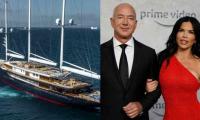See, history does repeat itself, even if it’s for karma. In 1962, exactly 60 years ago, the Cuban Missile Crisis took the world to the brink of World War III. The nuclear horrors of World War II were vivid at that time, so Kennedy and Khrushchev were able to keep a cool head, take a step back and diffuse the situation while saving face. This time, with the shoe on the other foot, will Biden and Putin be able to exercise some of that restraint? They will, if they have learnt anything from history.
After an intense deadlock, the Cuban Missile Crisis was averted when Khrushchev agreed to remove Soviet missiles from Cuba (placed in America's backyard at Cuban request after repeated US attempts to overthrow Fidel Castro, the Bay of Pigs Invasion being the final straw). In return Kennedy promised not to invade Cuba and to remove US missiles from Turkey (Soviet backyard then).
The resolution of the Cuban Missile Crisis resulted in a tacit arms and nuclear race by both sides that continued until the end of the cold war. World War II had helped jumpstart the idle US economy; the war created 17 million jobs, increasing industrial productivity by 96 percent. That’s one lesson Washington hasn’t forgotten. Economic slowdown since the Covid pandemic certainly drove the point home.
Two events of September 2021 were the psychological lynchpin for the Russian invasion of Ukraine: the completion of Nord Stream 2 gas pipeline between Russia and Germany and the withdrawal of American forces from Afghanistan. The rise of the Middle Hemisphere as the global economic pivot and the US having run out of places for military deployment without stepping on major toes (like that of China and its Road & Belt Initiative spanning nearly 70 countries and international organisations) has left Washington feeling like a third wheel.
To illustrate, let’s say Germany buys Russian gas for 100 euros per cubic meter. Whatever is left after domestic use is sold to the rest of Europe for 400 euros per cubic meter. The US doesn't want any further increase in Russia’s influence in Europe and the US also wants buyers for its very expensive shale gas. So, Washington wants Europe to buy American shale gas at 2,000 euros per cubic meter. That's right 100 vs 2000.
Now why would Europe, or for that matter anyone in their right mind, go for such a preposterous deal. Under normal circumstances, they wouldn’t – unless there’s a threat of war and the cheapest supplier also turns into the biggest enemy.
Europe depends on Russia for about 40 percent of its natural gas supplies. It has made remarkable advances in renewable energy but with climate change taking the global front seat, Europe’s dependency on natural gas is increasing as it shifts away from coal and nuclear energy.
The bulk of the natural gas from Russia flows to Germany through a number of supply channels like Yamal, Nord Stream-1 and some other pipelines that run through Ukraine. A pro-Russian government in Ukraine definitely earns Moscow a better deal on the pipeline transit fees. But more than that, if Ukraine joins the European Union and/or Nato, that would, one, allow Nato and by proxy the US to position their missiles right on Russia’s doorstep (Cuba & Karma), and two, Ukraine and by proxy the US will be able to influence Russian interests.
The military-industrial complex on both sides of the Atlantic has already started to benefit from the perceived Russia threat. Europe and the US have announced a string of weapon deployments along Nato’s eastern border. For the first time, the multinational Nato Response Force, comprising 40,000 troops, has been activated as a defensive measure in response to Russia's invasion of Ukraine.
The US has about 90,000 troops in Europe and for weeks the Pentagon has been repositioning them in the former Soviet bloc states of Eastern Europe. The Pentagon says this troop movement is temporary and defensive. Defensive it is, temporary not so much. Based on Russian attacks in Ukraine, this is one place where the US will be able to park troops for years to come.
The Ukraine crisis benefits both Moscow and Washington, but not Europe, which has been suffering from an ever-increasing energy crisis for some years now. Gas prices jumped by over 30 percent as soon as Russian forces entered Ukraine.
Another winner is China. If the Russian attack is successful in bringing about a regime-change in Ukraine, China will have a precedent to refer to in case of Taiwan. China has been trying to scratch that itch for a while now.
One of the pretexts for the 1962 Cuban crisis was the 1823 Monroe Doctrine of the US. The broad-based doctrine says that any intervention by external powers in the 'politics' of the Americas is a potentially hostile act against the US. It basically allows America to intervene anywhere in the world if it feels that US interests are at stake or threatened, like it did in Iraq and Afghanistan.
Moscow has taken a leaf out of this book. Russia draws its lineage from the 9th century Slavs of Ukraine, and even if a majority of the Ukrainians feel closer to the West today, their land carries historical and strategic importance for Moscow. Russia doesn’t want to occupy Ukraine; it only wants a pro-Moscow government in Kyiv.
Moscow also wants an assurance that Ukraine will never be allowed to join the European Union and Nato. While the US and the EU are finding it hard to give that assurance, no side wants a protracted war. Both know that it’s better to take a step back and restart the cold war than to plunge the world into chaos. A cold war is definitely more profitable than a war.
The writer is an executive producer, Geo News and editor of Jang – The Economist annual edition.
She tweets @munazza193
Approximately one in three women worldwide has experienced either physical and/or sexual intimate partner violence ...
Prime Minister Shehbaz Sharif has laid the foundation of a Daanish school in Islamabad’s Kuri Village
Ahfaz-ur-Rahman was also an Urdu poet of considerable reputation with his poems concerning a wide range of political...
In this picture taken on April 16, 2023, people throng a market area during shopping in Lahore. — AFPCare to cast...
A representational image of a transmission tower, also known as an electricity pylon. — AFP/FileLower electricity...
Pakistan's third Governor General Ghulam Muhammad. — National Portrait Gallery website/FileAs discussed in the...







